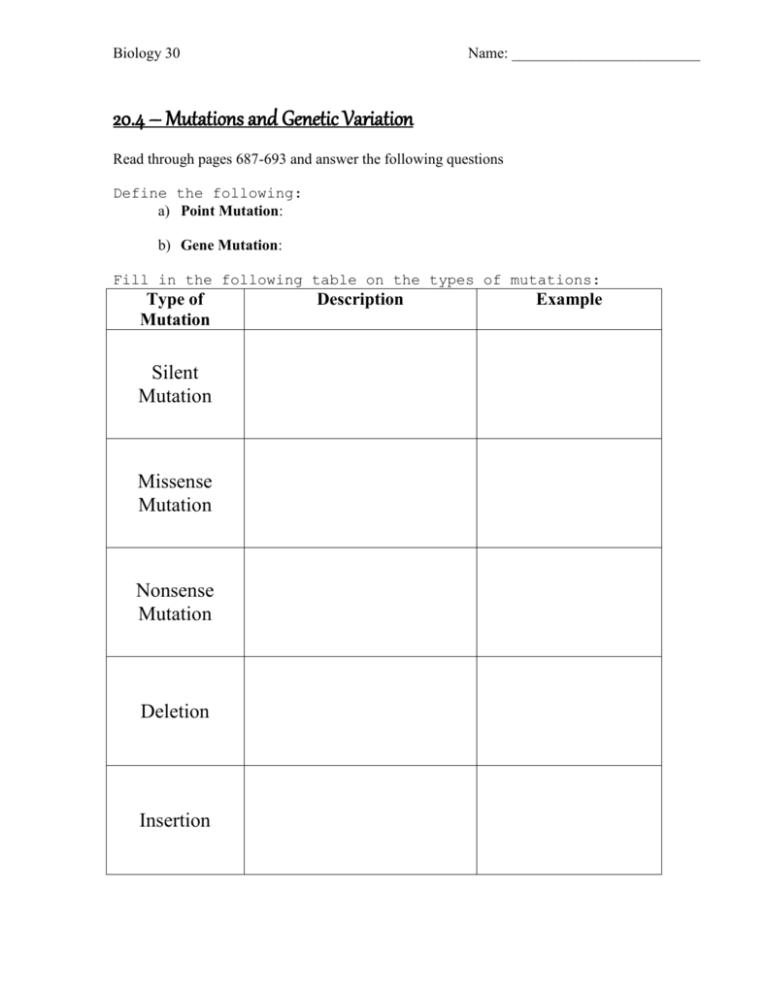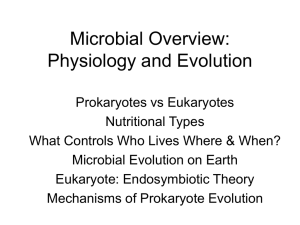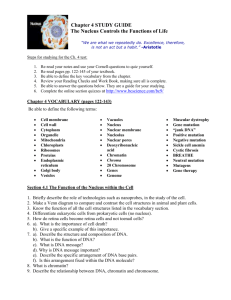DNA & ONCOGENES à Proteins in action,
advertisement

Biology 30 Name: _________________________ 20.4 – Mutations and Genetic Variation Read through pages 687-693 and answer the following questions Define the following: a) Point Mutation: b) Gene Mutation: Fill in the following table on the types of mutations: Type of Mutation Silent Mutation Missense Mutation Nonsense Mutation Deletion Insertion Description Example Frameshift Mutation Translocation Inversion Causes of Gene Mutations Some mutations are simply caused by an error during DNA replication and are known as ____________________________. Others arise from exposure to mutagenic agents and are known as _______________________________. Mutation Agents: Damaging Agent Mechanical Chemical Medications Radiation Replication Mistake Nutritional Biological Description Pushing or tugging the chromosome Mustard gas, nitrous acid etc Some antibiotics X-rays, UV light, cosmic rays As DNA replicates, natural mistakes do occur in S-phase of cell cycle Lack certain amino acids (essential) in the diet cannot make correct proteins in the right quantity Most viruses inject their DNA into ours that now becomes part of us If in gamete part of offspring! Inferring Relationships from DNA Sequences Define phylogeny: ________________________________________________________ ________________________________________________________________________ What two organelles in cells also contain their own DNA that is separate from the nucleus’ DNA? ___________________________________________________________ What is the difference between Mitochondrial DNA and nuclear DNA in how it is inherited? _______________________________________________________________ ________________________________________________________________________ ________________________________________________________________________ ________________________________________________________________________ Explain how base sequences in nucleic acids contained in the nucleus (or mitochondrial or chloroplast DNA) gives evidence for the relationships among organisms of different species. ________________________________________________________________________ ________________________________________________________________________ ________________________________________________________________________ ________________________________________________________________________ ________________________________________________________________________ ________________________________________________________________________ Do: Texbook Questions p.694 #2, 5, 7 (read through info from question #10, but you don’t need to do the research DNA & ONCOGENES Cancer = uncontrolled cell growth (division) What is an oncogene? A cancer causing gene present or developed in cells Often due to a “regulator” gene that has been mutated A “regulator” gene is necessary to control the function of other genes Normally “regulator” genes produce a “repressor” protein which binds to a oncogene (structural gene) turning it OFF! (see below) regulator gene oncogene Binds protein to oncogene (turns off) Produces Regulator protein If the regulator gene has mutated OR is removed, the repressor protein is missing OR its not functioning properly. Therefore, the “oncogene” gene may continue to act UNINHIBITED! (see below) If the structural gene is involved in cell division: For example IF helicase or gyrase the DNA will continue to unzip and replicate itself. The cells will continually divide uninhibited resulting in CANCER! Therefore, Cancer is either the mutation, or the movement of the regulator gene Cancer cells differ from normal cells in that they…. divide more quickly have no function do not adhere to one another move throughout the body (metastasis)









